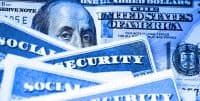 The Federal Reserve made a profit last year. It turned $79 billion of its $82 billion in “comprehensive income” over to the Treasury. The agency is an island of profit in the federal government that will lose nearly $1.5 trillion in the current fiscal year. The Fed’s success was based largely on appreciation of the value of mortgage-backed securities it holds along with other GSEs. Total Fed assets rose slightly year-over-year to $2.428 trillion.
The Federal Reserve made a profit last year. It turned $79 billion of its $82 billion in “comprehensive income” over to the Treasury. The agency is an island of profit in the federal government that will lose nearly $1.5 trillion in the current fiscal year. The Fed’s success was based largely on appreciation of the value of mortgage-backed securities it holds along with other GSEs. Total Fed assets rose slightly year-over-year to $2.428 trillion.
It is odd that the Fed, which put so much money into the credit system during the crisis, and the TARP, which had so much money at risk, each turned out to do so well financially. The credit crisis, it seems, was very good to the US government. Taken as a whole, it was bank shareholders who got the worst of the disaster. Investors in Lehman Bros. and Bear Stearns lost everything. The same was nearly true for holders of Citigroup (NYSE: C) and Bank of America (NYSE: BAC).
The riskiest move that the Fed made was to open a “window” to which banks could go and trade nearly worthless securities for cash. The banks were to pay the money back and did so in most cases. Congress has pressed for details on which banks took how much money, and those details are forthcoming.
An analysis of the eventual results of the credit crisis shows a odd result. The Federal government risked the most to salvage the financial markets, and for the most part, made the most. Government officials were clever enough to structure a bailout which included warrants which banks redeemed at nearly usurious prices. The government had the capital to risk. No other entity did. The entity with the money sets the terms.
The Federal Reserve has luck on its side. It could not expect that the value of mortgage-backed securities would improve somewhat and that it would have a gain. The fact that the Fed saved the bank system worked to its advantage. The central bank stanched the bleeding and in the process ended the sell-off of bad paper. In the process it enhanced the value of its own balance sheet because it put a foundation under the MBS market
The Fed may have been more lucky than good, but Bernanke will end up with the credit nonetheless. The Fed made a profit last year, which would have seemed impossible just two years ago.
Douglas A. McIntyre
Are You Ahead, or Behind on Retirement? (sponsor)
If you’re one of the over 4 Million Americans set to retire this year, you may want to pay attention.
Finding a financial advisor who puts your interest first can be the difference between a rich retirement and barely getting by, and today it’s easier than ever. SmartAsset’s free tool matches you with up to three fiduciary financial advisors that serve your area in minutes. Each advisor has been carefully vetted, and must act in your best interests. Start your search now.
Don’t waste another minute; get started right here and help your retirement dreams become a retirement reality.
Thank you for reading! Have some feedback for us?
Contact the 24/7 Wall St. editorial team.



